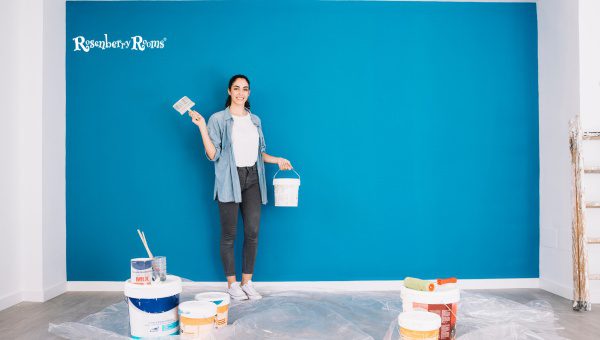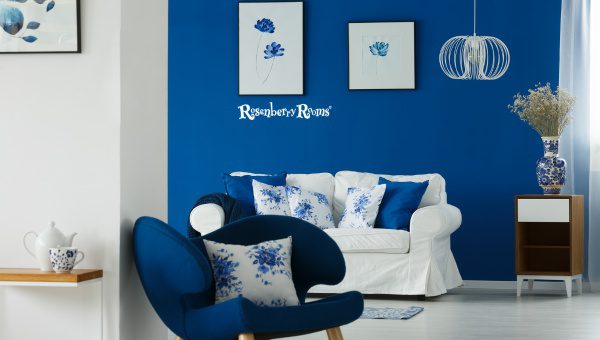Choosing the perfect shade of blue hue paint color for your walls requires a bit of insight and understanding. The process can feel intimidating with the broad spectrum of blues available, from sky blue to navy. This guide will provide essential tips on how to choose the best blue paint color that will complement your space perfectly.
We'll explore important factors such as how lighting changes the appearance of colors, why it's crucial to consider your existing décor when choosing a paint color, and ways to build confidence in selecting bolder shades of blue.
Whenever you're thinking about how to choose the blue hue paint color, remember that while aesthetics are significant, personal expression should also play a huge role in your final decision. Trusting your instincts is an integral part of this process, so embrace the adventure of revamping your space with a striking new hue.
Contents
Choosing the right Blue Hue paint color entails examining the atmosphere you want to create, considering lighting conditions, testing the paint before hitting the market, and complementing it with the rest of your decor.
There's no perfect formula for choosing paint colors. It will always depend on personal preference and the unique aspects of each room.
The blue color has a rich psychological effect, fostering sentiments of tranquility and composure. Known for its soothing properties, it instills a sense of serenity and repose. The hue is synonymous with steadiness and reliability, giving an aura of organization and structure.
It also harbors feelings of well-being and comfort, making it a popular choice for rooms intended for relaxation or reflection. Blue can soothe the mind, promote mental clarity, and foster a sense of spiritual enlightenment.

Selecting the ideal blue for your space is more than just grabbing a paintbrush and diving in. Various factors, such as the purpose and size of the room, its lighting, and existing décor, significantly influence your decision.
A color that evokes tranquility might work perfectly in a bedroom but feel out of place in a lively dining area. For every nook and cranny of your home, there's a perfect blue waiting to transform it.
When it comes to bedrooms and bathrooms, tranquility is usually the name of the game. Variations of light blue can create a serene and relaxing ambiance just right for unwinding at the end of a long day.
Try Soft Stream by Behr or Serene Breeze by Benjamin Moore for a soft and soothing aura. Consider going even lighter with an icy hue like Benjamin Moore's Icelandic for bathrooms.
Texture elements such as vanity finishes, tiles, or linens can affect how the color appears. So before you commit, sample your choices in different areas and note how they look throughout the day.
Living rooms are community spaces - all about gathering, spending time with family, or hosting friends. A bold shade of blue like Sherwin-Williams' Commodore can make the room feel expansive and inviting yet cozy in these spaces where we spend most of our time.
For dining rooms, an intense shade like Farrow & Ball's Stiffkey Blue gives an incredible depth that sets up a sophisticated dinner party atmosphere.
In kitchens, blues in cooler tones work best since they contrast well with warm wood tones commonly found in cabinetry.
Sticking to light to mid-tone hues works perfectly here- try Skylight by Farrow & Ball or Breath of Fresh Air by Benjamin Moore.
Study rooms could benefit from a darker tone that enhances focus, so contemplate a deep navy like Sherwin-Williams' Naval.
Test out small patches before making your final call - it's amazing how different a color can look when applied on large surfaces.
Also Read: 17 Best Blue Exterior Paint Colors In 2023 [Premium Colors]
Your creative journey doesn't have to start from scratch. Experienced interior decorators have tried-and-true favorites that grace homes nationwide with their compelling hues. Here are ten universally appreciated blues that have stood the test of time:
North-facing rooms can be tricky to decorate as they generally receive less sunlight, making them feel cooler and potentially a bit duller.
But before you throw in the towel, there's good news: Blues can work well here, especially if you go for more robust, vibrant shades.
A rich blue color like Benjamin Moore's Van Deusen Blue or Sherwin-Williams' Indigo Batik can work wonders in these spaces by adding depth and interest.
Remember to keep things balanced with light-colored furniture or accents to add warmth and avoid creating an overly gloomy atmosphere.
Southern rooms are sunnier and tend to make colors appear more intense due to the strong, warm light they receive most of the day.
This means that pretty much any shade of blue will shine beautifully, making south-facing rooms a joy to decorate.
Lighter hues such as Contented by Sherwin-Williams or Farrow & Ball’s Parma Gray will go far in maintaining an airy, bright room feel while adding an elegant touch.
If you're looking for a unique look, try a bold turquoise like Benjamin Moore's Teal Ocean. Don't forget that using paler hues on your ceiling will also help create an open and spacious appearance.

Light can significantly affect how shades and colors are perceived when painting. Particularly, blue hues can change dramatically depending upon the type, intensity, and direction of light present in a room.
Understanding daylight's influence on color is crucial. Here are some insights:
Your lighting fixtures and bulb choice can affect color perception, too. Below are some key considerations:
When choosing your optimal blue hue, remember its appearance will shift with changes in natural daylight and artificial light sources.
Explore More: How To Convert Old Under Cabinet Lights To LED [At No Cost]
A fresh white trim can archetypically contrast with your blue walls, making the color pop and adding an elegant touch to your room. Just like blue, there's a spectrum of white hues available.
Finding which one works best involves considering the mood you want to set and the undertones of your chosen blue.
Warm whites have a creamy, inviting feel that pairs well with rich or mid-tone blues. These whites often have undertones of yellow or red, which provide a comforting and cozy aesthetic against the coolness of blues like Sherwin-Williams' Naval. Consider options like Benjamin Moore's Ivory White or Behr’s Navajo White.
Nothing compares to a crisp, true white for a clean, timeless look. This is an excellent choice if you've chosen a vibrant or deep blue, as it provides stunning contrast without competing for attention, allowing your blue to shine. Check out Benjamin Moore's Super White for that sharp contrast effect.
Cool whites with subtle blue or gray undertones bring out the best in these hues if you've chosen a light or pastel blue shade.
Minimal yet modern, cool whites create tranquil spaces by softly blending with delicate blues, ensuring an airy atmosphere. Examples include Sherwin-Williams' Extra White and Farrow & Ball’s All White.

Choosing the right blue requires more than picking a swatch that catches your eye. Here's how to test your chosen color effectively:
Also Read: How To Test Paint Samples 2025 [6 Easy & Practical Tips]
Dipping into the diverse palette of blues, the sea of options can easily become overwhelming. But don't let this sweep you off your balance.
Remember that color is subjective, and personal preference should always be a part of your decision-making. Here are some crucial elements to guide your blue journey.
Follow these pointers, trust your instincts, mix in expert advice if needed, sample away, and watch as the perfect shade unfolds!
It's all about achieving balance and creating an environment that feels good to you. So, without further ado, put on that old T-shirt and let the transformation of your space begin!

Painting project costs aren't just what you spend on cans of paint. When purchasing your blue shade of choice, consider additional factors that can influence total expenditures.
Such cost variables include the size and condition of your painting surface, the paint quality, and whether or not you decide to hire a professional.
While each brand will vary in cost, consider these factors when tallying up potential expenses related to your decorating endeavors.
You don’t want any nasty surprises halfway through your transformation! Always ask for quotes and make essential comparisons before purchasing paint.
Navigating the world of blue paint colors can be quite a journey, and though you're bound to make some discoveries along the way, it's best to keep these common mistakes in check.
First, try not to get drawn into selecting a color based solely on its tiny paint chip. Colors can appear drastically different due to lighting changes or when scaled up onto a wall.
Also, avoid jumping the gun and purchasing gallons of paint before testing it in your space. Sample pots are invaluable tools for this process; use them!
Resist the urge to choose a color because it's trendy. Your home is an extension of you; what matters most is that you feel good when walking into a room.
One common mistake many make involves failing in color matching. You might think opposite colors on the color wheel will be a good contrast, but remember, such stark juxtapositions could become overbearing on large surfaces.
While you might love how a certain blue appears on your screen or magazine, remember that actual paint turns out somewhat different due to variations in printing processes and screen settings. Always test out samples on your surfaces before purchasing large quantities of paint.
Keep aware of your home's lighting, too - natural and artificial light can drastically alter how a hue appears from morning to night!
Brush sample swatches directly onto your walls so you see how each shade interacts with various elements within your space at different times of the day.
Read More: Benjamin Moore Arctic Shadows 1559 [Can Appear Smoky Blue?]
Lighter shades of blue, like sky blue or icy blue, can make a small room appear larger and more open.
Cooler blues often contrast well with warm wood tones. Try a mid-tone hue like 'Skylight' or 'Breath of Fresh Air'.
Yes, shades such as Robin's egg blue or aqua create an airy, inviting feel perfect for kitchens.
Both natural and artificial light can dramatically change how your chosen blue appears throughout the day - always test with samples first.
Soft and soothing blues such as 'Soft Stream' or 'Serene Breeze' would help create a calming ambiance perfect for bedrooms.
As you can see, finding the perfect shade of blue involves more than just picking a swatch that catches your eye. It requires consideration of the room’s purpose, the lighting conditions, existing furnishings, and, of course, your taste.
The key takeaway here? Always test colors in your own space before making a final decision. You'll be surprised how much lighting and surrounding elements can influence how a shade ultimately appears on your walls.
It's all about finding what makes your space feel like you - comfortable, welcoming, and truly home. Don't be afraid to experiment and let your creativity shine – it's paint!